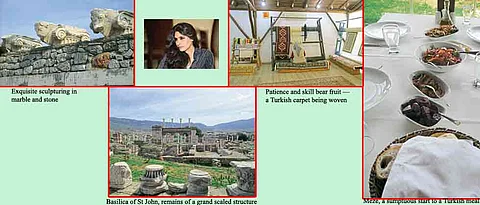

It was like turning the clock back to recreate moments of the past. As guide Ismail narrated tales of yore, I could visualise robust men clad in robes moving about elegantly, sagacious old men with their heads bent pensively in making political decisions, and pretty maidens near fountains engaged in light banter and gay laughter.
Colossal marble columns play sentinel to what remains of aesthetically designed monuments — both ornamental and functional, mosaiced streets, fountains, baths, markets and temples. Reminiscent of a golden era of the Roman empire, the ancient city of Ephesus offers nostalgia.
Built in the 10th century BC by Attic and Ionian Greek colonists, Ephesus progressed and prospered under the Romans. Its location at a point where sea and land meet, gave it a commanding position as an important trading centre. It was also a religious centre for Christ’s apostles, St John and St Paul. The city had a chequered history which is reflected in the Ephesus Museum’s display of archaeological and ethnographical artefacts from Prehistoric, Mycenaean, Archaic, Classical, Hellenistic, Roman, Byzantine, Seljuk and Ottoman periods. Ephesus saw grand constructions and devastating destructions which a half-day tour of the cityscape reveals.
After an explanation of the historical background, we set off to wander through the large expanse. The Temple of Artemis, one of the seven wonders of the ancient world, and for which Ephesus was famous, is today just the remains of the foundation of what was once a marble edifice with sculpted pillars. The statue of the many-breasted Artemis — a symbol of the temple and of abundance, is exhibited at the Selcuk Museum.
The Varius Bath is a lavish set up where men and women at different designated times, indulged in a regime starting with exercise at a fitness centre, followed by luxuriating in a cold bath, a warm bath and lastly, a hot bath. The citizens apparently had a love of leisure and pleasure.
An interesting feature is the stone inscriptions in Greek and Latin. Messages about important events and announcements were archived by inscribing from paper scrolls onto stone tablets, thus making these history pages in stone.
Built on a burial chamber, the Celsus Library is a three-storeyed building with an impressive façade. The Great Theatre where happy audiences applauded, the Theatre Gymnasium for physical and mental training activities, the Hellenistic Fountain which received water supply from the Marnas River, the Trajan Fountain — a reservoir, Milestones indicating distances between ancient cities, the Bouleuterion which housed Parliament meetings, musical performances and contests, the House of Pleasure — supposedly a brothel, the public latrine, the Temple of Hadrian, the Basilica Stoa, Agora market and a shopping street were among the other facets we explored.
A history buff, I was deeply satisfied and ready for the religious sojourn through Ephesus. Peace reigns at the House of Virgin Mary, considered to be Mother Mary’s home in her last days. This pilgrimage site was discovered in 1892 based purely on the visions (which proved accurate) of a German nun, Anna Katharina Emmerick (1774-1824). The Roman-style stone chapel was rebuilt on the original structure which dates back to the 1st and 4th centuries. I said a prayer and went to see the Sacred Fountain and the Wishing Wall believed to make one’s wishes come true.
Lunch at a Turkish restaurant was divine. Meze — aubergines and other veggies in tomato sauce, carrots with garlic yoghurt, red chilli paste, beet pickle, bread and cheese rolls — was an explosion of flavours. Rice and “bulgur” (cracked wheat) with chicken and sauteed vegetables comprised the main course. Tahini Helwa topped with orange slices was the perfect finish to a delectable meal.
A brief visit to a weaving centre ensued. I watched in admiration the village women’s sleight of hand as they wove intricate motifs (crops, flowers and love-notes) into woollen, silk and cotton carpets. The rich texture and designs were hard to resist and I bought myself a small carpet as a memory of Ephesus.
We proceeded to the Basilica of St John. Tradition says that St John came to Ephesus with Mother Mary, and wrote his Gospel here. On the southern slope of the Ayosolug Hill, a small chapel stood over St John’s grave in the 4th century. Later, Emperor Justinian and Queen Theodora built a cruciform-shaped basilica crowned with six domes. Today, a glance at the ruins alludes to its magnificence and grandeur of scale. The body of St John is said to have been removed by the Roman Crusaders and the Turkish invasion saw part of the church converted to a mosque. The tour concluded here and we set off to drive back to Izmir.
The images I had seen stayed in my mind long after I left the city behind. What a mighty empire, what lavish living! And today, one walks through rubble. But in spite of the scars left by nature and history, Ephesus is a worthwhile journey.
ST Reader Service
Currency: Turkish Lira
Best time to visit: Mid March to May and September to November
